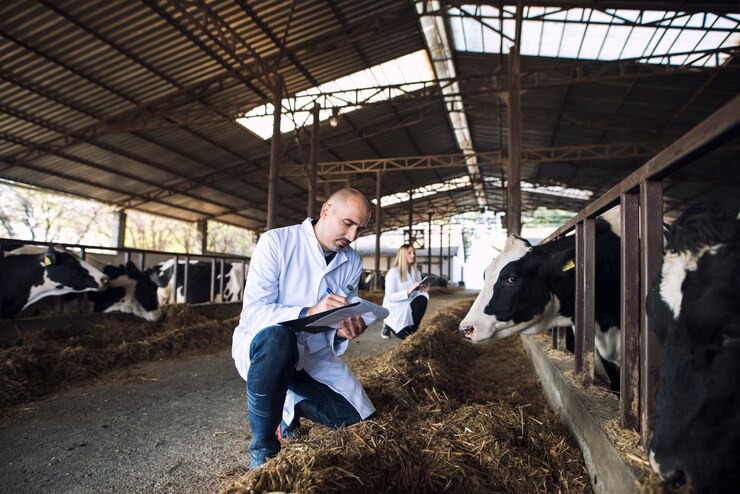Cattle feeders are indispensable tools in the management of cattle nutrition, ensuring that livestock receive a balanced and nutritious diet to support growth, reproduction, and overall health. From traditional trough feeders to modern automated systems, cattle feeders come in various forms to accommodate different herd sizes, feeding practices, and management goals. In this article, we’ll explore the importance of cattle feeders, their types, and key considerations for selecting the right feeder for your operation.
Importance of Cattle Feeders
Cattle feeders play a crucial role in optimizing feed management and maximizing the efficiency of feed utilization in beef and dairy cattle operations. By providing a steady supply of high-quality feed, cattle feeders help meet the nutritional requirements of cattle at various stages of development, from calves to mature breeding stock. Proper nutrition is essential for supporting optimal growth, reproduction, and milk production, as well as maintaining overall herd health and productivity.
Types of Cattle Feeders
There are several types of cattle feeders available, each designed to meet specific feeding requirements and accommodate different herd sizes and management practices:
- Trough Feeders: Trough feeders are one of the most common types of cattle feeders, consisting of long, narrow troughs that allow multiple cattle to feed simultaneously. They’re typically made of durable materials such as steel or plastic and can be mounted on the ground or suspended from overhead structures. Trough feeders are versatile and suitable for feeding a variety of feedstuffs, including hay, silage, and grain.
- Bunk Feeders: Bunk feeders are similar to trough feeders but typically larger and deeper, allowing for higher feed capacities. They’re commonly used in feedlots and dairy operations to provide feed to large numbers of cattle efficiently. Bunk feeders can be stationary or portable, making them suitable for various feeding systems and management practices.
- Self-Feeding Systems: Self-feeding systems, such as free-choice hay feeders or grain feeders, allow cattle to access feed at their convenience without the need for manual distribution and Agricultural irrigation system installation. These systems are particularly useful for extensive grazing systems or operations where labor availability is limited. Self-feeding systems can help reduce labor costs and ensure continuous access to feed, especially during periods of high demand.
- Automated Feeding Systems: Automated feeding systems utilize technology to deliver precise amounts of feed to cattle at predetermined intervals. These systems may include robotic feeders, feed wagons, or feed bunk management systems that monitor feed intake and adjust feeding schedules accordingly. Automated feeding systems offer increased efficiency and precision in feed management, allowing producers to optimize feed utilization and reduce wastage.
Considerations for Choosing Cattle Feeders
When selecting cattle feeders for your operation, several factors should be taken into account to ensure optimal performance and cost-effectiveness:
- Herd Size and Composition: Consider the size and composition of your cattle herd, as well as their nutritional requirements and feeding behavior. Choose feeders that can accommodate the number of cattle you have and provide adequate access to feed.
- Feed Type and Handling: Different types of feed require different feeder designs and handling mechanisms. Ensure that the feeder you choose is compatible with the type of feed you’ll be using and can deliver it efficiently to your cattle.
- Durability and Maintenance: Invest in feeders made from durable materials that can withstand heavy use and harsh weather conditions. Regular maintenance and inspection are essential to prolonging the life of your feeders and ensuring safe and efficient feeding operations.
- Cost and Efficiency: Consider the cost-effectiveness of different feeder options, taking into account factors such as feed wastage, labor requirements, and long-term durability. Choose feeders that offer the best balance of cost and efficiency for your operation.
Conclusion
Cattle feeders are invaluable tools in the management of cattle nutrition, providing a reliable and efficient means of delivering feed to livestock. Whether it’s trough feeders, bunk feeders, self-feeding systems, or automated feeding systems, selecting the right feeder for your operation is essential for optimizing feed management and maximizing herd productivity. By considering factors such as herd size, feed type, durability, and cost-effectiveness, cattle producers can choose feeders that meet their specific needs and contribute to the success of their operations.
Have A Look :-
- 10 Best Hot Tub Gazebo Ideas
- 10 Most Comfortable Couch Ideas
- 10 Deck Skirting Ideas To Protect Your Deck


